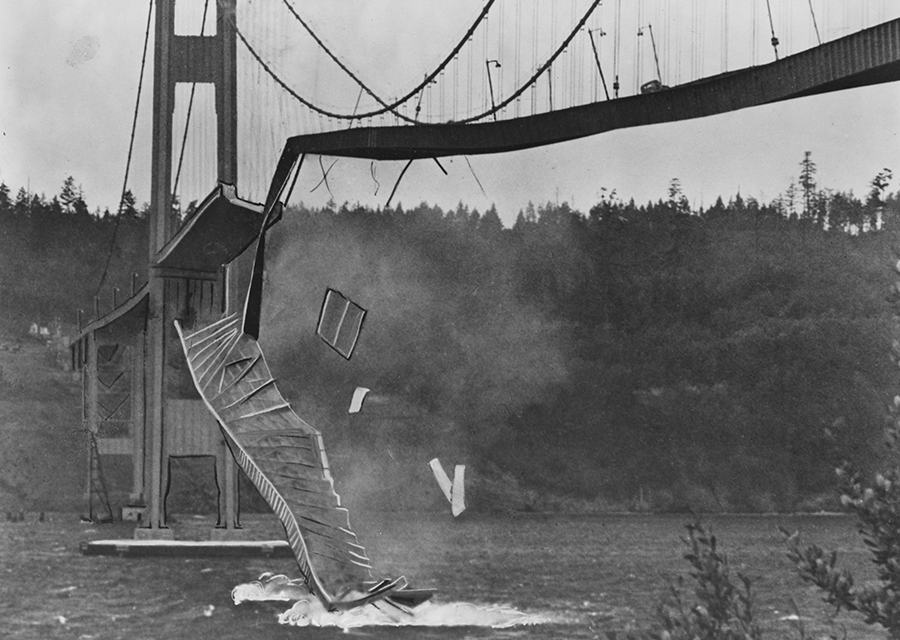High winds took down the Tacoma Narrows Bridge on November 7, 1940, just four months after it was erected, because designers stressed aesthetics over structural integrity. Locals called the wobbly bridge “Galloping Gertie.”
Henry Petroski is a professor of civil engineering and history at Duke University. His first book, To Engineer Is Human: The Role of Failure in Successful Design, appeared in 1985. This spring brought his 17th, To Forgive Design: Understanding Failure. Petroski is a student of catastrophe and what it can teach us.
Does design matter?
A flawed artistic design can wreck a performance or a career, but an engineering failure can kill people.
What is engineering?
The avoidance of failure. In designing a structure, you have to anticipate how that structure could fail, so that you can include features that don’t allow failure to occur. Engineers are doing the same things today that they were doing a hundred years ago, a thousand years ago, 2,000 years ago.
Why did America exert such a powerful pull on engineers?
In the late 19th and early 20th centuries, America was building some of the tallest buildings, the largest bridges and the biggest dams in the world. These projects attracted engineers from around the world. Othmar Ammann, who designed the George Washington Bridge and the Verrazano Narrows Bridge, came from Switzerland to have an opportunity to build bridges of a scope he wouldn’t encounter in Europe. Ralph Modjeski, a Pole who studied in France, became one of our greatest bridge builders.
What are the greatest American engineering triumphs?
The skyscraper. The long-span suspension bridge. The industrial research and development lab.
What are some great failures?
In the 19th century, there was a series of terrible steamboat explosions. The 1976 collapse of the earthen Teton Dam in Idaho. The 1940 collapse of the Tacoma Narrows Bridge.
How can engineers get it wrong if designs are based on good math?
Over-confidence and self-importance can blind them. A lot of famous failures have involved the flip side of the can-do spirit—engineers who believe there’s nothing they can’t do. Engineers also can be blinded by fashion. Design goes in waves. By the 1930s, the aesthetic feeling in the profession was that the Brooklyn Bridge, while solid and safe, had come to seem clunky. The new aesthetic paradigm—the George Washington Bridge—made engineers want to build bridges that looked very slender, like ribbons of steel. Nobody believed they were designing unsafe bridges, but bridges became increasingly flexible. That’s what led to the Tacoma Narrows Bridge failure.
How so?
Some engineers said the bridge was too slender. The chief consulting engineer, Leon Moisseiff, had worked on the design of every major suspension bridge in America since the Brooklyn Bridge. He pulled rank. “I’m the expert,” Moisseiff said. “We’re going to build the bridge this way.” Four months later the bridge collapsed.
Does history matter in engineering?
It’s very important. Galileo tells about a marble column being put into storage. At first it was laid atop supports at either end. A worker said the column might sag and crack, so the crew added a support at the midpoint. The workmen didn’t realize the ground underneath either end was softer than the soil at the middle. The end supports settled, the middle support acted as a fulcrum and the column broke. This illustrates that any change can introduce a new way for a structure to fail—a principle that is as true today as it was in Galileo’s time.
What led to the failure of the I-35W Bridge in Minneapolis five years ago?
The cause is yet to be decided in court. The design had one feature—the gusset plates—that turned out to be under-designed. The bridge was also fracture-critical. If one essential piece of steel in the assembly broke, the entire bridge could collapse. Many structures around us depend on a single critical part. Still, that Minneapolis bridge carried traffic safely for 40 years.
How long should a bridge last?
A hundred years is not uncommon. The Brooklyn Bridge is more than 100 years old. One limit on lifespan is that older bridges originally were designed for lighter loads. It’s not engineers who allow heavier trucks to use bridges; it’s politicians who just pass laws and seem to give no thought to the possibility that they may be overloading existing bridges. It’s insane but it’s done all over the country.
Why don’t engineers get respect?
Engineers were well thought of until World War II, when scientists got most of the credit for accomplishments like the Manhattan Project and radar. Scientists like Robert Oppenheimer often are more articulate and have larger egos than engineers.
Where are the most ambitious engineering jobs these days?
In the Far East new wealth is financing ambitious projects like Malaysia’s Petronas Towers, which until recently were the world’s tallest buildings. Many of the principal engineers on the Petronas Towers project were educated in the U.S.
What are the important engineering jobs besides bridges and dams?
Engineering plays a big role in medical devices and drug delivery systems. In an operating room or an examining room, what you see are creations of engineering.





